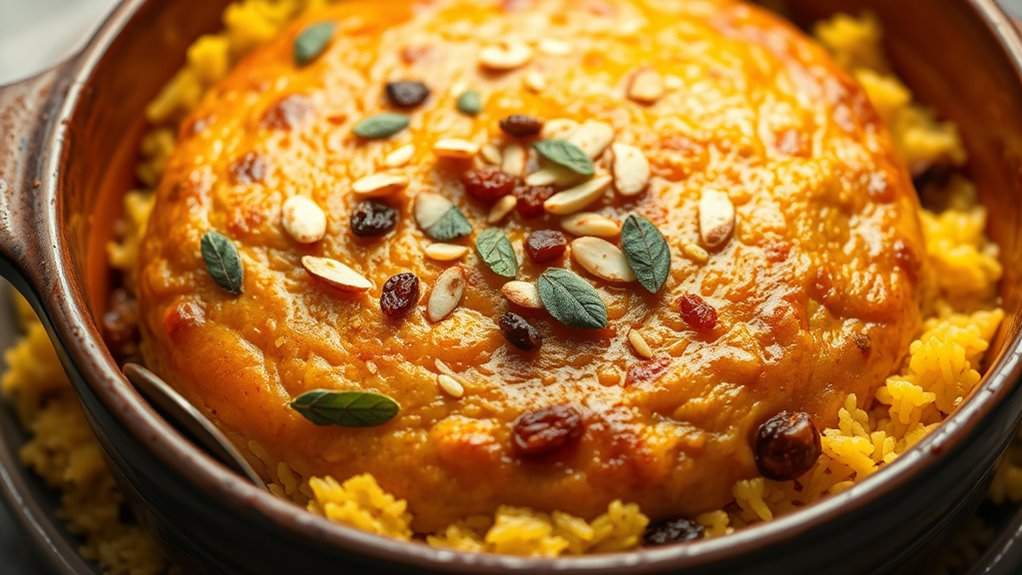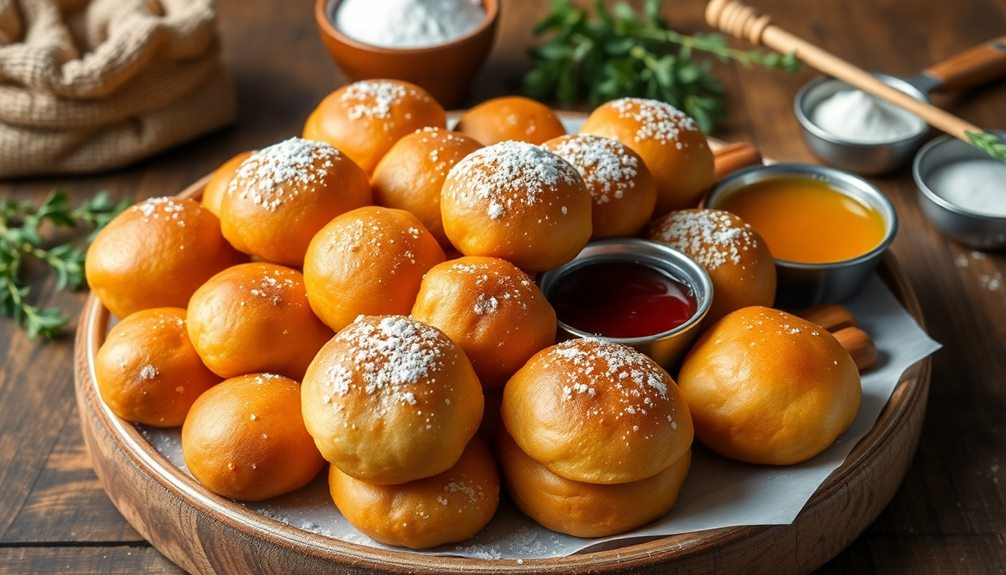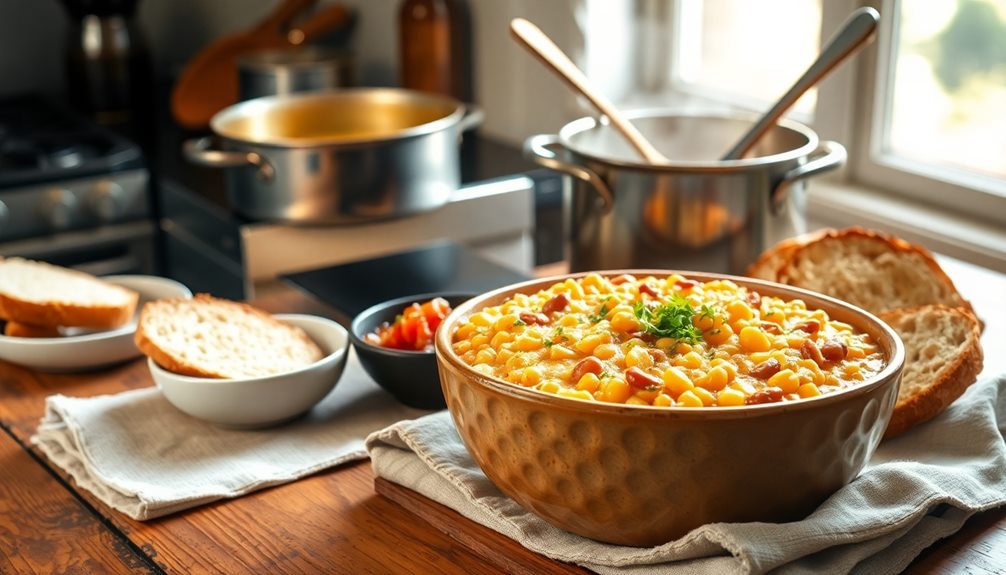South African Bobotie is a flavorful dish that combines spiced ground meat, often beef or lamb, with ingredients like raisins and apricots, reflecting Cape Malay culinary traditions. You’ll notice a blend of warm spices such as turmeric, cumin, and cinnamon, creating a rich, aromatic flavor profile. The dish is topped with a custard made from eggs and milk, then baked until golden. If you keep exploring, you’ll discover more about its cultural significance and unique ingredients.
Key Takeaways
- Bobotie is a traditional South African dish rooted in Cape Malay culture, blending Indonesian, Malaysian, Dutch, and Indian influences.
- It features a spiced ground meat mixture with turmeric, cumin, coriander, and cinnamon, topped with an egg custard before baking.
- Common ingredients include beef or lamb, dried fruits like raisins, and aromatic spices, creating a warm, complex flavor.
- The dish symbolizes South Africa’s multicultural heritage and is celebrated for its comforting, aromatic profile.
- Serving typically includes rice or bread, making Bobotie a popular, culturally significant culinary tradition.

Have you ever wondered what makes South African Bobotie a beloved traditional dish? The secret lies in its unique blend of flavors, achieved through careful spice blending that has been passed down through generations. This dish embodies a rich culinary history rooted in Cape Malay culture, reflecting a fusion of influences brought by traders, settlers, and enslaved peoples. As you prepare Bobotie, you’ll notice how the spices aren’t just ingredients—they tell a story of cultural exchange and adaptation, giving the dish its distinctive aroma and taste. The spice blending typically includes turmeric, cumin, coriander, and a touch of cinnamon, creating a warm, aromatic profile that’s instantly recognizable. These spices are not added randomly; they’re thoughtfully combined to balance sweetness and savory depth, creating a complex flavor that’s both comforting and exciting. Additionally, the use of regional specialties and artisanal ingredients helps to attract regional customers and celebrate local culinary traditions. Understanding the culinary history behind Bobotie helps deepen your appreciation for its flavors. Originating from the Cape Malay community, it’s a dish that encapsulates centuries of history, blending the culinary traditions of Indonesian, Malaysian, Dutch, and Indian cuisines. The spices used are a testament to this multicultural heritage, each brought by different communities that settled in South Africa. Over time, these influences melded into a single dish that’s now considered a national treasure. When you cook Bobotie, you’re not just making a meal—you’re recreating a piece of history, experiencing the legacy of diverse cultures coming together through spice blending. The use of dried fruits like raisins or apricots adds a subtle sweetness, balancing the heat and earthiness of the spices, and reflecting the influence of Indian flavors. The meat, traditionally beef or lamb, is mixed with bread or soaked crumbs to keep the dish moist, then topped with a custard made from eggs and milk before baking. The final touch, often a sprinkle of bay leaves or a dash of turmeric, enhances the aroma and presentation. As you serve Bobotie, you’re sharing more than just a meal—you’re offering a taste of South Africa’s vibrant history and cultural mosaic. Every bite reveals layers of flavor created by skillful spice blending, echoing centuries of culinary evolution. This dish’s enduring popularity lies in its ability to bring people together through its complex, comforting flavors, making it a true reflection of South Africa’s diverse heritage. So next time you prepare Bobotie, remember that you’re not just cooking; you’re preserving and celebrating a rich culinary history that continues to thrive today.
Frequently Asked Questions
What Are the Origins of Bobotie?
You might find it fascinating that bobotie’s origins trace back to historical influences from Indonesian, Malaysian, and Dutch cuisines, blending spices and cooking techniques. Its cultural significance in South Africa reflects a rich history of Cape Malay communities and colonial interactions. As you enjoy this dish, you’re experiencing a culinary tapestry that showcases diverse traditions, making bobotie not just a meal but a symbol of cultural fusion and heritage.
Can Bobotie Be Made Vegetarian?
Yes, you can make bobotie vegetarian by using plant-based proteins like lentils, chickpeas, or textured vegetable protein (TVP). These vegetarian alternatives mimic the texture and flavor of meat while keeping the dish hearty and flavorful. Just replace the meat with your chosen plant-based protein, add traditional spices, and top with a sweet custard-like layer. It’s a delicious, meat-free twist on the classic Cape Malay curried bake.
What Are Traditional Side Dishes Served With Bobotie?
You should serve bobotie with traditional side dishes like yellow rice, sambals, or a fresh salad to complement its rich spices. For spice pairings, consider chutneys or fruit preserves to enhance the curry flavors. Serving suggestions include garnishing with chopped fresh herbs and serving with a side of fragrant yellow rice. These options balance the dish’s bold flavors and make your meal more vibrant and satisfying.
How Long Does Bobotie Last in the Refrigerator?
You can store bobotie in the refrigerator for up to 3-4 days. For best results, use airtight containers and follow proper storage tips to keep it fresh. When reheating, cover it with a microwave-safe lid or wrap and heat on medium until warmed through, stirring occasionally. Reheating gently preserves its flavor and texture, making it easy to enjoy leftovers without sacrificing quality.
Are There Regional Variations of Bobotie Within South Africa?
You’ll find regional variations of bobotie across South Africa, each bursting with unique flair. In Cape Malay areas, vibrant spice blends and sweet chutneys create a symphony of flavors, while in other regions, the dish might lean more towards savory or even fiery styles. This culinary fusion reflects local ingredients and traditions, making every bite a delicious adventure through South Africa’s diverse cultural tapestry.
Conclusion
Remember, in cooking as in life, patience and tradition create the best results. South African bobotie blends bold spices and comforting textures, offering a taste of Cape Malay heritage. As the saying goes, “Good things come to those who wait.” So, take your time to prepare this curried bake with love. Enjoy every bite, knowing you’re savoring a dish that’s rich in history and flavor—truly a culinary treasure worth sharing.










